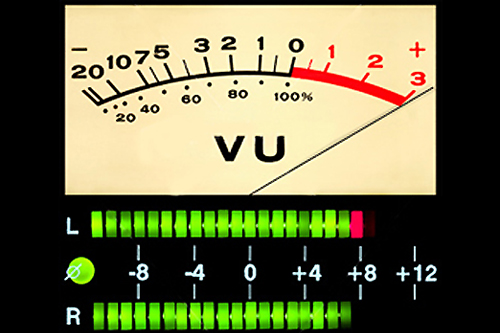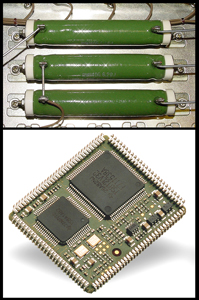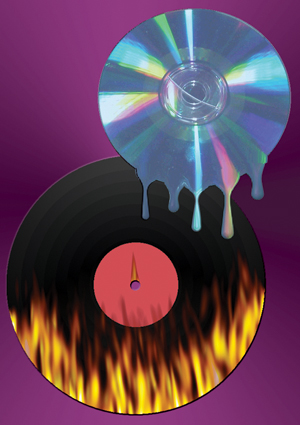
Zeroes & Ones
Simply, the numerical representation of a slice of audio frozen in time could be either above or below a threshold. There are just two choices: on or off. The resulting one-bit audio would sound like a nasty guitar fuzz box.
Greater precision in measurement leads to more faithful reproduction of the sound we wish to preserve. We could choose to record sound as a stream of numbers using our familiar decimal system, based on our 10 fingers.
But digital electronic circuits are much more comfortable with the binary system of counting, where instead of 10 different levels there are only two, represented by zero and one.
The string of numbers flip by like the frames of a cartoon to create the illusion of a continuously variable analog of the original sound. The faster the pictures flip by every second and the better the picture quality the more realistic the illusion of movement in the cartoon, and so it is in audio, where a higher sampling rate and longer word length results in better quality digital audio.
When we put up a microphone and create an audio signal chain between the natural sound and what comes out the other end, we are putting our faith in the equipment manufacturers.
Just as we have a palette of choices in creating that signal chain, manufacturers have a broad palette of components to choose from when creating the piece of equipment that we choose to run our sound through.
While the equipment designer is picking just the right resistor, capacitor, or digital signal processor, he has to keep in mind a slew of constraints placed on him, such as reliability, end cost to the customer, support, appearance, and so on.
So a lot of the talent a designer brings to a product is the ability to make the right balance of compromises to deliver a cost-effective solution for the customer. And this is what makes one product or technology a better choice than another. So where do they go right and what are the traps?
Playing The Numbers
More is better, right? In our society, we tend to be impressed by bigger numbers. If 16-bit audio sounds better than 8-bit audio, then 24-bit audio must sound even better.
Manufacturers wow us with science. They tell us that their analog to digital converters have 24-bit performance.
A simple engineering rule of thumb says that we get about 6 dB of signal-to-noise improvement with every bit we add. This means that 24-bit audio has a dynamic range of six times 24, or 144 dB.
Yet when we read the specs, we’re lucky to see 118 dB out of a so-called 24-bit converter. So the difference between the claim of 24 and the reality of not even 20 is called “marketing bits.” They are in there to make you and I believe we are getting something more.
Dynamic range is just one measure of performance. Other measurements, such as distortion, similarly fall short of the claimed number of bits.
So our 24-bit converters are really 20-bit converters. But 20 bits is still impressively good when you consider dynamic range—the difference between the loudest sound and the noise floor.
But these are just measurements. Unfortunately, measurements aren’t always a true indicator of how something is going to sound.
Often we find that a piece of gear sounds great even though its specs leave something to be desired. The key is clean conversion in and out, and numeric precision once inside the box. Once digital equipment designers have transferred the analogue audio into their digital world, they use math to manipulate the sound.
Functions such as EQ involve repetitive processing of numbers. If the digital circuits don’t maintain enough precision, noise and distortion can creep into the pristine digital audio.
It’s like balancing your checkbook. If you only paid attention to the dollars and ignored the cents, your balance would be off by more and more each month. The rounding-off to the nearest dollar causes a bigger and bigger problem the more you do it.
Whether it’s the digital signal processor in your digital console or the hardware in your laptop, care has to be taken not to allow the small rounding errors to creep up on you and cause noise and nasty distortion.
And here’s where we encounter a fundamental difference between analog and digital audio: There’s good distortion and there’s bad distortion.
Good & Bad
What sounds “good” depends upon whom you ask. That is, it’s a subjective matter to a great extent. Those firmly in the analog audio camp point to an indefinable emotional impact inherent in non-digital sound.
Audiophiles and purists still prefer the open and natural sound of recordings on vinyl, for example, when compared to what they consider the harsh, cold, or unemotional sound on compact discs.
But what is the accepted norm also plays into the equation.
The audio world is transitioning to digital at a rapid pace. In post-production and music recording, two areas that were among the first to make the digital transition, the entire process, from ingestion of the source material to outputting the finished product, can take place entirely within the digital domain.
The television and radio broadcast industries have also been busy making the transition to fully digital operation over the last few years.
The last bastion of analog audio is live sound. But there, too, over the last few years, the tools have begun to emerge that have allowed engineers to set up systems that, except for the transducers at either end of the signal path, are wholly digital.
Arguably, beginning with the widespread availability of CDs during the 1980s, there has been a widespread acceptance of digitally delivered music as being perfectly satisfactory, even preferable to analog methods.
Yet analog in the 1960s, ‘70s, and ‘80s seemed somehow more pure, within the limits of the available technology.


